Written by Charlie Hulme
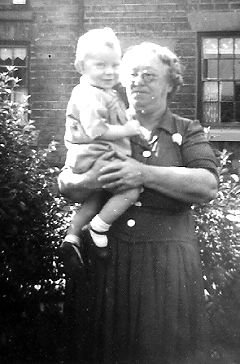
Rachel Middleton was born Rachel Downs in 1887 in Market Terrace in New Mills, a town three miles from Whaley Bridge, to John Goodwin Downs and his wife Emily, and by the age of 14 was working as a winder in a local cotton mill. By 1911 the family - John, Emily, Rachel and younger sister Sarah Elizabeth, had moved to Canal Street, Whaley Bridge. Rachel was still working, and Sarah Elizabeth (aged 22) is described by her father in the 1911 census record as 'Winder in Cotton Mill, sick at home'.
John Downs described his house in 1911 as no. 16 Canal Street, but the Enumerator on his 1911 summary sheet called it no.21. It was a small house with just four rooms: probably the small cottage now known as No.13.
Street numbering in Canal Street is confusing for historians. Houses were numbered in the traditional way with 'evens' on one side and 'odds' on the other, but it was only physically possible to build on the 'odd' side, and at some time this was recognised and the houses were renumbered in a consecutive series. The situation in Canal Street is further complicated because the present No. 11 was at some time part of the adjacent house, Pear Tree Cottage.
Sarah Elizabeth Downs was working as a dressmaker when she married George Peter Bagshaw in 1913. She died in Chorley, Lancashire in 1968. On Sarah's death her two sons - Rachel's closest relatives and executors of her will - had no wish to be landlords of houses in the Whaley Bridge area, and were keen to sell them to the sitting tenants.
In 1915 Rachel Downs married Henry Fawcett Middleton, who in 1911 was working as a printworks labourer living with his father William Middleton in Grove House, Furness Vale, a village between Whaley Bridge and New Mills. William Middleton was described as 'Gentleman living on own means' - in earlier years he had been the farmer at Diglee Farm, and before that a grocer. Around 1918 they moved into Pear Tree Cottage (see below).
Henry Fawcett Middleton (known as Harry) died on 13 April 1937 aged only 52, and tragically their only child Mary, Mary Middleton, died in 1940 aged only 23, after choking on a fish bone. Rachel lived alone in Pear Tree Cottage for many years afterwards; she died in 1969, aged 82.
John Goodwin Downs died in 1927; his widow Emily lived until 1943. John Goodwin Downs, Emily Downs, Henry Fawcett Middleton and Mary Middleton are buried in a family grave in St Georges Road Methodist graveyard in New Mills.
The mineral water works
Although I knew that our house at 11 Canal Street was connected a mineral water bottling plant which had operated in the semi-derelict buildings behind, as my father recalled it from his childhood, its history has always been vague in my mind. However while working on tbis piece I discovered an item on the Furness Vale Local History Society website which makes things clearer:
'William Morten, one time landlord of the Dog and Partridge [pub in Bridgemont] had established his mineral water business in Whaley Bridge by 1856. His first premises were at Rosey Bank above the Cock Hotel, later renamed Jodrell Arms. Building of the railway required his re-location to Pear Tree Cottage in Canal Street. In 1889 he bought the property from the executors of its previous owner, John Vaux, together with Vaux’s Row, later Johnson Street and the Navigation Inn. The business was taken over in 1895 by Joshua Rhodes, a previous partner. Mineral waters continued to be manufactured until the business was sold in 1918 to John William Grundy who transferred production to his Stockport site.
'Joshua Rhodes also had a carriage hire business and operated in 1901, the first local bus service between Whaley Bridge and New Mills.'
The water supply for the works was from a well in the cellar of Pear Tree Cottage, which was apparently connected with the well on the other side of the road which had been the supply at the original site.
My late father was born in 1910, so his memories of the mineral water bottling works must have been from his early childhood. I remember him describing how they would steal the bottles, which were of the type with a glass ball inside which was held against the top by the pressure of the carbon dioxide, and break them to use the glass ball in games of marbles.
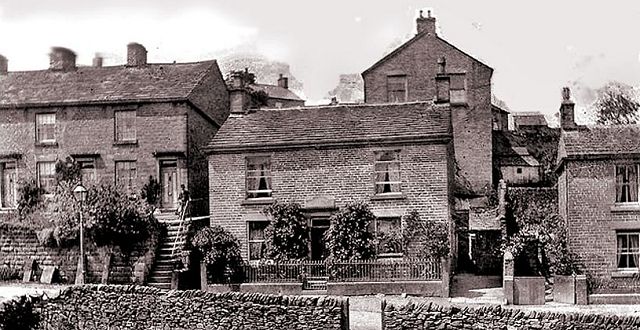
The Spring Bank Terrace area, from an old photograph. No.5 (formerly No.8) is at the top of the long flight of steps. The house in the centre was the home and surgery of two generations of local General Practitioners Drs. Allan. Source: Whaley Bridge photos website.
Her father, her father-in-law and her husband appear to have invested their savings in property, with the result that Mrs Middleton came to own a number of terraced houses in the Whaley Bridge area, including No.5 Reservoir Road, also known as 5 Spring BankTerrace, which was rented by my grandfather Albert Hulme and his family. This end terraced house, part of a terrace built c.1853, had been purchased in 1934 by Henry Fawcett Middleton.
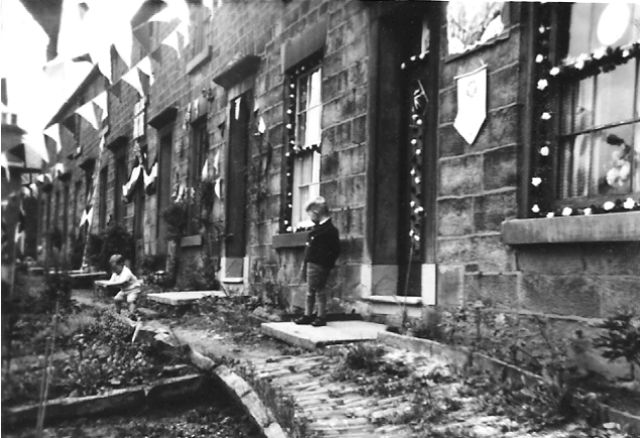
Spring Bank Terrace decorated for the Coronation in 1953. That's me nearest the camera. Picture by Agnes Hulme.
By the time my mother, Agnes Hill, married Albert's son Charles in 1948, the little house was home to Charles, his sisters Marion and Beatrice, and Beatrice's daughter. After the wedding, my mother moved in as well, but when I was 'on the way' Mrs Middleton found another of her houses, No.12 Canal Street, for us to live in at a very reasonable rent. Having lost her own daughter, she took a great interest in my welfare, and became my 'Aunty Middleton.' A few years later, the larger cottage next door at No.11 Canal Street became vacant, and we moved in for a reasonable weekly rent of 12 shillings, at a time when my father was working as a labourer for eight pounds per week. On top of this we had a few shillings to pay in Rates which went to the council.
This rent remained more or less unchanged until I bought the house in 1971 from Mrs Middleton's nephews. The land on which these houses, the builders's yard, the Navigation Inn, and the houses on the north side of John Street, stand was leased for 999 years by Francis Jodrell, Lord of the Manor of Taxal, to a William Taylor in 1814. Our share of the 'ground rent' came to £2 per annum; the lease made no provision for increasing this sum, and I understand this is still payable by the current houseowners in 2016 - apparently now to the Deutsche Bank.
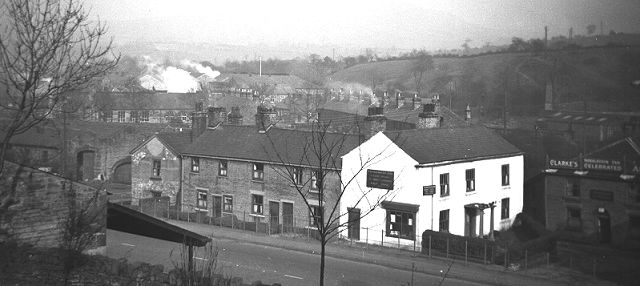
Canal Street, c.1950. Pear Tree Cottage is the white building, with No.11 to the left, then nos. 12, 13 and the canal house. The Navigation Inn is on the right. Picture by Agnes Hulme.
Our back door was a short walk from that of Pear Tree Cottage, and my childhood memories are mostly of her walking uninvited into our house for a 'chat' on a regular basis. It seemed irritating at the time, but of course she was very lonely in the big house and was really very kind to us. Sometimes I would run errands for her and help with things - in her last years she became confused and struggled to cook for herself; looking back I know that I should have been more grateful to her, and to a number of other Whaley Bridge residents who helped our family along the way.
After Mrs Middleton died, Pear Tree Cottage was for a while the home of Fred Branson, retired landlord of the nearby Goyt Inn, and his wife Jessie, before eventually becoming a café - as it remains in 2016. The strange carved stone heads which stood on top of the porch have mysteriously disappeared at some time. The shop front on the Canal Street side of the building, which I recall from the '50s and '60s as a showroom for Drinkwater's builders whose yard was nearby, more recently has been the home of Pear Tree Print. The whole Canal Street area is now a Conservation Area, and the white house at the north end of the row, Canal Cottage, is a Listed Building.
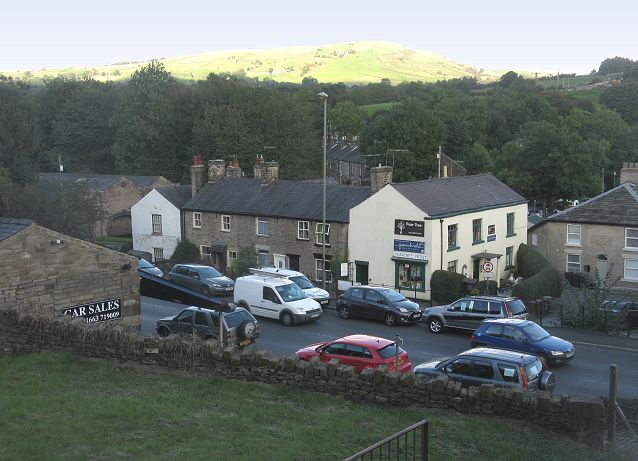
Canal Street, 2016. The Navigation Inn has become
another 'lost pub', and the former A6 road (by-passed some years ago)
is strewn with cars. I believe the Manchester - Buxton Turnpike in its
early days followed the lower level which is now Canal Street, and the
present route with its retaining walls was a later addition.
I married in 1985 and moved to Stockport; my mother remained at 11 Canal Street until her death at Christmas 2002. The house was sold in 2003, and has been rebuilt internally to a less eccentric layout, without the two cupboards which were actually sealed-off doorways to Pear Tree Cottage, and the downstairs bathroom which was partly under the stairs of No.12.
No.5 Reservoir Road also remained with the family for many years, surviving a dramatic lightning strike in the 1950s. Marion Hulme left in the 1960s on marrying postman Walter Lamb, Beatrice and her daughter Ivy remained; with her husband John and son Nigel they were the last residents from our family. In 2016 the house was noted undergoing a complete rebuild after being sold in 2015.
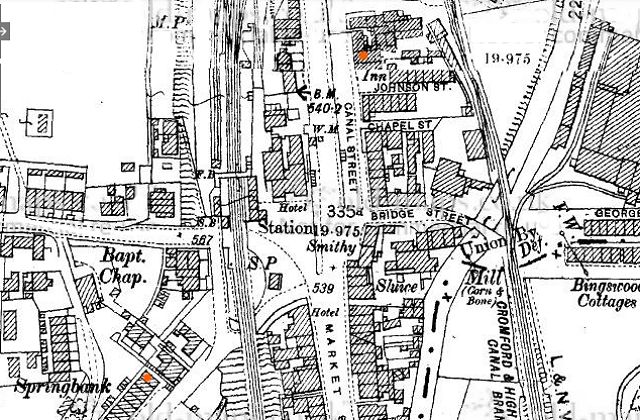
Whaley Bridge, c. 1900. Marked in red are Pear Tree Cottage (upper) and No.5 Spring Bank Terrace. At that time, and until boundary changes in 1936 when it was incorporated into Derbyshire to join the rest of the village, this part of Whaley Bridge west of the original course of the River Goyt (shown on the map), was in Cheshire, and known as 'Yeardsley-cum-Whaley'. The boundary can be seen on the bottom right of the map following the river; it deviated to the east around the Goyt Mill weaving shed, because the river was diverted when the mill was built in 1865.